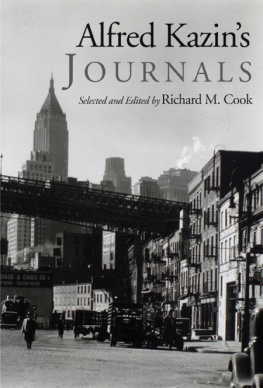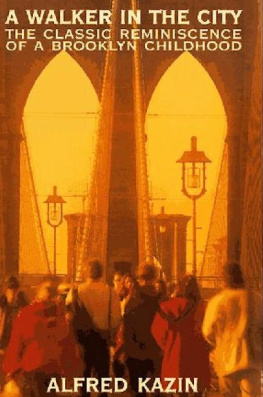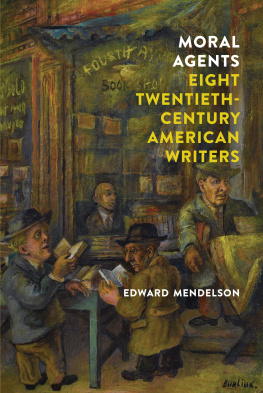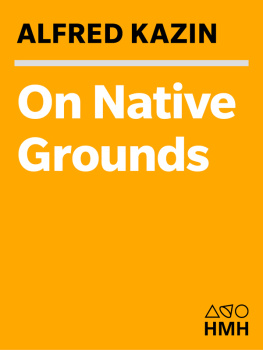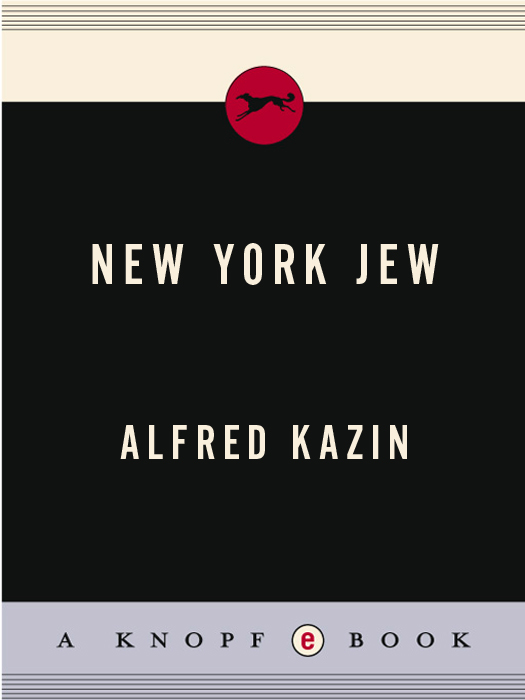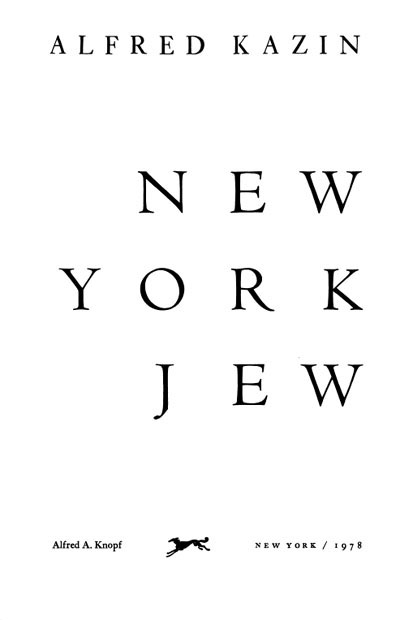also by Alfred Kazin
ON NATIVE GROUNDS:
An Interpretation of Modern American
Prose Literature
A WALKER IN THE CITY
THE INMOST LEAF
CONTEMPORARIES
STARTING OUT IN THE THIRTIES
BRIGHT BOOK OF LIFE
American Novelists and Storytellers
from Hemingway to Mailer
Editor
THE PORTABLE WILLIAM BLAKE
F. SCOTT FITZGERALD
The Man and His Work
THE STATURE OF THEODORE DREISER
(with Charles Shapiro)
MELVILLES MOBY-DICK
(Riverside Edition)
RALPH WALDO EMERSON
A Modern Anthology
(with Daniel Aaron)
THE OPEN FORM
Essays for Our Time
THE SELECTED STORIES OF NATHANIEL HAWTHORNE
HENRY JAMES, THE AMBASSADORS
Portions of this book are based on material by Alfred Kazin
that has appeared elsewhere in different form.
Several names in this book have been changed.
THIS IS A BORZOI BOOK
PUBLISHED BY ALFRED A. KNOPF, INC .
Copyright1978 by Alfred Kazin
All rights reserved under International and Pan-American Copyright Conventions. Published in the United States by Alfred A. Knopf, Inc., New York, and simultaneously in Canada by Random House of Canada Limited, Toronto. Distributed by Random House, Inc., New York.
Grateful acknowledgment is made to the following for permission to reprint previously published material: Harcourt Brace Jovanovich, Inc.: Excerpts from COMPLETE POEMS 19231962, by E.E. Cummings. Harcourt Brace Jovanovich, 1972. Hill & Wang: Except from The Distant Runners from COLLECTED AND NEW POEMS , 19241963, by Mark Van Doren. Copyright1963 by Mark Van Doren. Reprinted by permission of Hill & Wang (now a division of Farrar, Straus & Giroux). Houghton Mifflin Company: Excerpts from Permit Me Voyage from THE COLLECTED POEMS OF JAMES AGEE , edited by Robert Fitzgerald. Houghton Mifflin Company, 1968. Liveright Publishing Corporation: Excerpt from THE COMPLETE POEMS AND SELECTED LETTERS AND PROSE OF HART CRANE , edited by Brom Weber. Reprinted with permission of Liveright Publishing Corporation. Copyright 1933, 1958, 1966 by Liveright Publishing Corporation.
Library of Congress Cataloging in Publication Data
Kazin, Alfred [date]
New York Jew.
1. Kazin, Alfred [date] 2. CriticsUnited
StatesBiography. 3. American literature20th
centuryHistory and criticism. I. Title.
PS 29. K 38 A 36 810.9 [ B ] 781932
eISBN: 978-0-8041-5126-9
v3.1
FOR CATHRAEL KAZIN
CONTENTS
Chapter I
WORDS
Chapter II
MIDTOWN AND THE VILLAGE
Chapter III
YOU MUST CHANGE YOUR LIFE
Chapter IV
JOURNEY IN WARTIME
Chapter V
ENGLAND: THE LAST BATTLE
Chapter VI
NEVER HAD IT SO GOOD
Chapter VII
THE TIMES BEING WHAT THEY ARE
Chapter VIII
THE NEW LIFE
Chapter IX
GROWING UP IN THE SIXTIES
Chapter X
WORDS
Chapter I
WORDS
Anything can happen now that weve slid over this
bridge, I thought, anything at all.
The Great Gatsby
One dreamlike week in 1942 I published my first book, On Native Grounds, became an editor of The New Republic, and with my wife, Natasha, moved into a little apartment on Twenty-fourth Street and Lexington. Its casement windows looked out on a shop that sold everything you could possibly need for your horse. From across the street the shop seemed to gleam with silver rein buckles, brightly polished saddles and bridles. In front of the shop stood a prancing, thoroughly affable wooden horse painted bright yellow.
I had never lived in Manhattan before. In those first few weeks of my arrival in the big city I went between my home, my publishers at Lexington and Twenty-eighth and The New Republic at Forty-ninth and Madison in a dizzy exaltation mixed with the direst suspicion of what might happen next. Riding away from the office at the violet hour in the sudden opulence of wartime, when the incomparable autumn light of New York still hung over the buildings that would soon be shadowed by the faint wartime brownout, I could feel, when the taxi skidded around the circular passageway under the ramp of Grand Central into Fourth Avenue, sensations of personal deliverance that came and went like the light between the arches. I was stupefied by the advance interest in my book, which would soon give me a considerable boost at The New Republic; I loved working in the center of New York and living in Manhattan. Riding home at the rush hour, I could taste all the wild distraction of New York in wartime like a first martini. But I missed my long solitary days in the Forty-second Street Library, I was expecting at every moment to be called into the Army, and I was not prepared for so much good fortune.
I had begun my book in our single room in Brooklyn Heights soon after our wedding at City Hall. It was 1938. We were twenty-three, we had known each other two weeks, Natasha was taking her doctorate in bacteriology at Bellevue, and we were both in a terrible rush to get away from everything we had grown up with. Beginning my book in a mood of great husbandly contentment, I soon knew that thanks to an idle suggestion from Carl Van Doren, who liked my first reviews and literary essays, I had found my natural subject. Van Doren wondered why there had never been a study of the new American writing in the twentieth century that would also be a historical explanation of its emergence.
For almost five years I had worked toward the book in the great open reading room, 315, of the New York Public Library, often in great all-day bouts of reading that began when the place opened at nine in the morning and that ended only at ten at night. With my friend Richard Hofstadter, who was writing Social Darwinism in American Thought for his doctorate at Columbia, I would snatch my lunch in the Automat across the street from the Library, run up Fifth Avenue in the brownout for exercise, find a pool parlor off Times Square for a hurried game of Ping-Pong, then return to the great yellow tables in 315, somehow always smelling of fresh varnish and piled with our books, on which we had left little notes saying BACK SOON , DO NOT DISTURB . We spent an afternoon every week in the Trans-Lux Newsreel Theatre on Broadway and solemnly congratulated each other the day we were privileged to look at lines of heavy tanks lumbering off the Detroit assembly lines like new automobiles. War, blessed war, had come to the rescue of my generation, and nothing would ever be the same.
I had written my book at the kitchen table in Brooklyn Heights; on Forty-first Street near the El in Long Island City; at Provincetown in the summer of 1940; and the last summer at Yaddo in Saratoga, where, as I saw Natasha walking away down Union Avenue to her train, I was blinded by my tears and the grief that was to come. For almost five years I had lived in a state of scholarly innocence, of unexpected intellectual assurance that floated my book home on the radical confidence of the 1930s. I had gone back and forth between the subway and 315, between Bryant Park and 315, between the Automats coffee spigot and 315, between Natashas influenza lab at Bellevue and 315.


